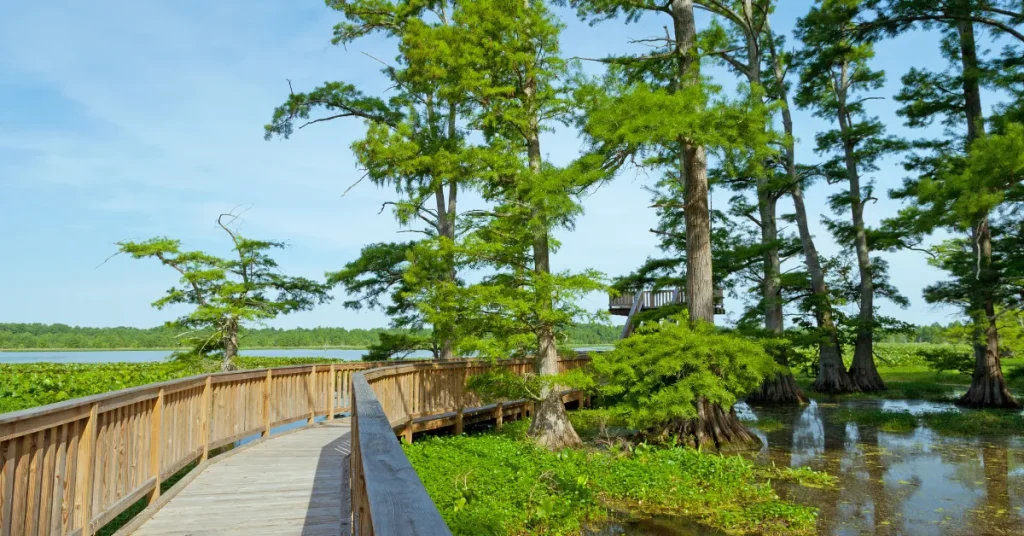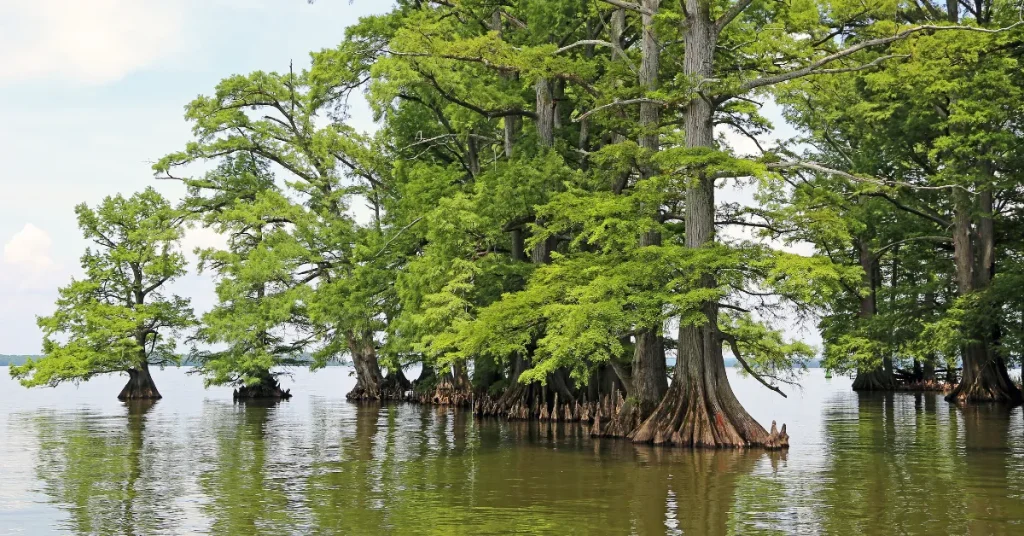Reelfoot Lake, located in Tennessee, averages a depth of 5-6 feet. Its maximum depth reaches about 18 feet.
Nestled in the Northwest corner of Tennessee, Reelfoot Lake serves as a testament to nature’s raw power and beauty.
This natural lake, formed during the New Madrid earthquakes of 1811-1812, stretches over 15,000 acres, with its shallow waters fostering a diverse ecosystem.
Known for its rich fishing grounds and birdwatching opportunities, Reelfoot Lake attracts outdoor enthusiasts year-round. Its unique flooded forest landscape provides a haven for various wildlife species, establishing it as a critical habitation area for ecological research and enjoyment.
The lake’s shallow depth and abundant cypress trees make it an iconic fishing and boating destination, steeped in history and local folklore.

Plunging Into Reelfoot Lake’s Depths
Amidst the natural wonders of Tennessee, Reelfoot Lake presents an aquatic enigma worth exploring.
Crafted from seismic activity over a century ago, its depths offer more than just water—they tell a story of geologic upheaval and a unique habitat. Let’s dive in and explore what lies beneath the surface of this intriguing body of water.
Measuring The Lake’s Profile
The task of measuring Reelfoot Lake’s bottom is vital to understanding its ecology. Scientists and geographers employ various tools to map out the lakebed.
They use sonar equipment to send sound waves into the deep, which bounce back to render an accurate picture of depth and terrain. The data collected paints a detailed portrait of the lake’s underbelly.
Key statistics about Reelfoot Lake:
- Average Depth: 5 to 6 feet
- Maximum Depth: 18 feet
- Total Surface Area: 15,000 acres
Comparing Depths: Reelfoot Vs. Other Lakes
When placed side by side with other lakes, Reelfoot’s depths reveal its unique character. Unlike the Great Lakes or Crater Lake’s profound basins, Reelfoot is comparatively shallow.
This shallow nature supports a diverse range of aquatic plants and wildlife, creating a thriving ecosystem.
| Lake | Average Depth | Maximum Depth |
| Reelfoot Lake | 5-6 feet | 18 feet |
| Great Lakes | 80-200 feet | Up to 1,332 feet |
| Crater Lake | — | 1,943 feet |
Reelfoot’s modest depths create a haven for fishers and nature enthusiasts alike. The lake’s shallow expanses ensure warm waters teeming with life, providing ideal conditions for various fish species.
This makes Reelfoot Lake a popular destination for those seeking a peaceful day of fishing or bird watching.
Formation: The Birth Of A Natural Wonder
Reelfoot Lake in Tennessee is not just a body of water; it is a story of earth’s incredible power to create. This lake stands as a testament to the raw forces that can sculpt our landscape in moments.
Born over the course of just a few months, Reelfoot Lake was a result of dramatic changes in the earth’s geology that left a lasting natural wonder.
The New Madrid Earthquakes
Powerful tremors shook the ground in 1811 and 1812. They were the New Madrid earthquakes. They were some of the strongest quakes North America has ever recorded. The ground cracked and roared, leaving behind a changed land.
These earthquakes made the Mississippi River flow backwards. Because of this, waters flooded the forests. This event marked the beginning of Reelfoot Lake.
Subsequent Flooding And Geology
The New Madrid shakes led to massive flooding. The water covered the land. Winter rains fell, filling the newly-formed basin. Mudslides blocked the river’s path. The floods created what we now know as Reelfoot Lake.
Enormous amounts of water slowly made a new lake. Over time, the water calm down. It left behind a unique ecosystem. Reelfoot Lake now supports a wide variety of plant and animal life.
The Ecosystem Beneath The Surface
The Ecosystem Beneath the Surface of Reelfoot Lake is as intriguing as the waters are deep. This aquatic environment is not just about depth but about the vibrant life it sustains below its surface.
Habitat Diversity
Reelfoot Lake’s bottom structure is a complex web of habitats. From submerged logs to underwater ridges, the lake’s floor is a patchwork of environments that support life. Each area is crucial for different species, offering places to feed, hide, and breed.
- Cypress Stumps: Provide safe spots for fish and invertebrates.
- Muddy Bottoms: A playground for bottom-dwellers like catfish.
- Weedy Ledges: Act as nurseries for young aquatic species.
Resident Species And Biodiversity
Biodiversity in Reelfoot Lake is astounding, with multiple species calling it home. Each organism plays a part in the ecosystem, ensuring its health and longevity.
| Fish | Amphibians | Invertebrates |
| Bluegill | Frogs | Crayfish |
| Catfish | Salamanders | Snails |
| Bass | Newts | Dragonfly Larvae |
Flocks of birds thrive on the abundance of fish. Plants like lily pads provide shade and oxygen, crucial for aquatic life. With such rich diversity, Reelfoot Lake’s ecosystem is a treasure trove of nature’s wonders.
Mysteries And Legends Of Reelfoot

Reelfoot Lake holds deep secrets beneath its waters. Created by a series of violent earthquakes in the early 19th century.
This lake in Tennessee is not only notable for its biological diversity but also for the many stories and legends that ripple across its surface.
Native American Lore
The waters of Reelfoot Lake whisper tales of a fierce giant. Native Americans believed this giant, angered by the unrestrained joy of their ancestors, stamped his foot and caused the earth to shake, giving birth to the lake.
Legends tell of a beautiful princess abducted by this giant, creating a tale of love and tragedy. These stories are woven into the fabric of the lake’s history and are a testament to its mystical origins.
Modern Anecdotes And Sightings
Recent years have seen peculiar sightings that add a modern twist to Reelfoot’s folklore. Anglers speak of sudden, inexplicable waves and hunters tell of eerie calls heard across the water.
Some believe these are signs of the ancient giant, while others suggest they’re the works of hidden creatures lurking in the lake’s depths.
- Intriguing reports of large, unidentified tracks on the shoreline.
- Unusual movements in the water during still nights.
- Local tales of an old hermit who vanished near the lake, sparking ghost stories.
Each sighting contributes to the lake’s air of mystery, drawing visitors and folklore enthusiasts keen to explore the unknown.
Exploration And Conservation Efforts
The enigmatic beauty of Reelfoot Lake has long captivated naturalists and adventurers alike. Nestled in the northwest corner of Tennessee, Reelfoot Lake holds the title of the state’s largest natural lake.
The depths of this remarkable body of water and its surrounding ecosystem provoke questions and intrigue.
Exploration and conservation efforts at Reelfoot Lake blend the thrill of discovery with the imperative of protecting this unique environment for future generations.
Research Expeditions
The history of Reelfoot Lake is as deep and varied as the waters themselves. Curiosity drives ongoing research expeditions to map and understand the lake’s depths. Teams of scientists and researchers employ advanced technology:
- Sonar equipment to chart underwater topography
- Water sampling to analyze aquatic health
- Wildlife monitoring to track species populations
These expeditions aim to uncover the mysteries of Reelfoot Lake, from its unique formation to its ever-evolving ecosystems.
Protecting Reelfoot’s Future
Conservation is more than a practice; it’s a promise to protect Reelfoot’s rich natural heritage. The lake is home to a vast array of wildlife, including several endangered species. Conservation programs in place prioritize:
- Habitat preservation for future research
- Educational outreach to foster community awareness
- Eco-friendly tourism to encourage sustainable visitation
Collaborative efforts among conservationists ensure the lake thrives while remaining a beacon for learning and exploration.
Recreational Activities And Tourism

Reelfoot Lake offers splendid opportunities for outdoor enthusiasts. Unique in depth and history, this shallow body spans across 15,000 acres, with average depths of 5 to 6 feet and a maximum depth of about 18 feet.
Visitors flock annually to engage in varied activities amidst the lake’s serene beauty and vibrant ecosystem.
Fishing And Boating
Fishing at Reelfoot Lake is a year-round adventure. Anglers of all levels find joy in the abundant populations of:
- Crappie: Known for its delicious taste.
- Bass: A challenge for sport fishing fans.
- Bluegill: Perfect for families and novice anglers.
Many public piers and boat ramps dot the shoreline, offering easy access to the water.
Boat rentals and guided tours enhance the experience, letting visitors explore hidden coves and the lake’s diverse wildlife.
Bird Watching And Hiking
Reelfoot Lake is a paradise for bird watchers. With more than 240 bird species, the area boasts remarkable birding trails. Notable sightings include:
| Season | Species |
| Winter | Bald Eagles |
| Spring | Warblers |
| Year-round | Waterfowl |
For those seeking tranquility, hiking through the cypress forests is captivating. Traversing boardwalks and trails, visitors experience the lake’s natural splendor.
Educational signage along the paths provides insight into the local flora and fauna. This makes the experience both enjoyable and informative.
FAQs About How Deep Is Reelfoot Lake
What Is The Average Depth Of Reelfoot Lake?
Reelfoot Lake’s average depth is approximately 5 to 6 feet, with deeper channels reaching up to 18 feet. This relatively shallow depth is consistent across most of the lake’s area.
How Deep Is The Deepest Part Of Reelfoot Lake?
The deepest point of Reelfoot Lake is around 18 feet. These deeper areas are primarily channels created by seismic activity during the lake’s formation.
Can You Fish In The Shallow Waters Of Reelfoot Lake?
Yes, fishing is possible in Reelfoot Lake’s shallow waters. The lake is renowned for crappie and bass fishing, especially in the partially submerged timber areas.
What Makes Reelfoot Lake’s Depth Unique?
Reelfoot Lake’s unique depth is a result of the 1811–1812 New Madrid earthquakes. It’s shallowness supports a diverse ecosystem, making it a hotspot for bird watching and fishing.
Conclusion
Navigating the depths of Reelfoot Lake reveals a blend of history and natural beauty. With an average depth of 5-6 feet and areas reaching up to 18 feet, it’s perfect for both fishing and exploring.
Remember, this unique lake’s charm lies just as much beneath the surface as it does above.
Keep exploring, keep discovering, and let Reelfoot Lake’s waters be your guide.
